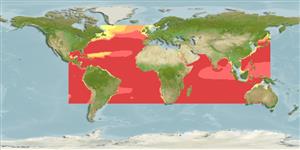>
Stomiiformes (Lightfishes and dragonfishes) >
Phosichthyidae (Lightfishes)
Etymology: Pollichthys: Because of Dr. Max Poll, ichthyologist (Ref. 45335).
Eponymy: Dr Max Fernand Leon Poll (1908–1991) was a Belgian ichthyologist, and ‘connoisseur of the fish fauna’. [...] Günther Edmund Maul (1909–1997) was a German ichthyologist and taxidermist who lived and worked most of his life in Madeira. [...] (Ref. 128868), visit book page.
More on author: Poll.
Environment: milieu / Zona climática / intervalo de profundidade / distribution range
Ecologia
marinhas batipelágico; oceanódromo (Ref. 51243); intervalo de profundidade 100 - 600 m (Ref. 3988), usually 300 - 600 m (Ref. 47377). Deep-water; 60°N - 34°S, 98°W - 144°E
Eastern Atlantic: as far north as 60°N, 20°W (Ref. 4778); Canary Islands (Ref. 4470) to off west African coast (Ref. 3988). Western Atlantic: Gulf of Mexico (Ref. 27768). Elsewhere, North Atlantic (60°-30°) and western Pacific.
Tamanho / Peso / Idade
Maturidade: Lm ? range ? - ? cm
Max length : 6.0 cm SL macho/indeterminado; (Ref. 3988)
Descrição suscinta
Chaves de identificação | Morfologia | Morfometria
Espinhos dorsais (total) : 0; Raios dorsais (total) : 10 - 12; Espinhos anais: 0; Raios anais : 22 - 30. Dark dorsum, flanks silver (Ref. 3988). Slender body, longer anal fin and tail set (Ref. 37473).
Body shape (shape guide): elongated.
An oceanic and mesopelagic species, adults and juveniles usually found at 200-500 m by day and the majority of them migrate into upper 100-200 m at night. Feeds mainly on small crustaceans. Dioecious with peak spawning during summer. Adult photophore complement attained at about 25-27 mm SL (Ref. 4778).
Ciclo de vida ou comportamento de acasalamento
Maturidade | Reprodução | Desova | Ovos | Fecundidade | Larvas
Quéro, J.-C., J.C. Njock and M.M. de la Hoz, 1990. Photichthyidae. p. 343-348. In J.C. Quero, J.C. Hureau, C. Karrer, A. Post and L. Saldanha (eds.) Check-list of the fishes of the eastern tropical Atlantic (CLOFETA). JNICT, Lisbon; SEI, Paris; and UNESCO, Paris. Vol. 1. (Ref. 4470)
Status na Lista Vermelha da UICN (Ref. 130435: Version 2025-1)
Ameaça para os humanos
Harmless
Uso pelos humanos
Pescarias: bycatch
Ferramentas
Relatórios especiais
Baixar XML
Fontes da internet
Estimates based on models
Preferred temperature (Ref.
123201): 6.5 - 14.5, mean 10.2 °C (based on 705 cells).
Índice de diversidade filogenética (Ref.
82804): PD
50 = 1.0000 [Uniqueness, from 0.5 = low to 2.0 = high].
Bayesian length-weight: a=0.00316 (0.00131 - 0.00766), b=3.17 (2.95 - 3.39), in cm total length, based on LWR estimates for this (Sub)family-body shape (Ref.
93245).
Nível Trófico (Ref.
69278): 3.7 ±0.58 se; based on food items.
Resiliência (Ref.
120179): Elevada, tempo mínimo de duplicação da população menor que 15 meses (Preliminary K or Fecundity.).
Fishing Vulnerability (Ref.
59153): Low vulnerability (10 of 100).
🛈
